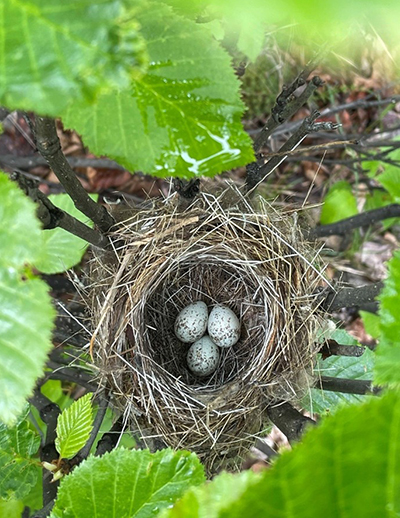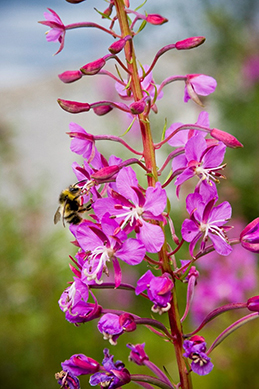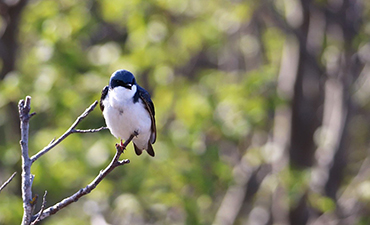Alaska Fish & Wildlife News
April 2023
Landscaping for Wildlife

Spring is around the corner in Alaska and with it the arrival of migratory birds and pollinators, hibernating mammals waking up, frozen frogs thawing out, and the start to gardening season. Landscaping and gardening activities can benefit Alaska’s wildlife and if done intentionally, help promote coexistence with our incredible natural biodiversity. Here are some tips to make your backyard more friendly to your local critters this spring and summer.
Making a Plan
To enhance your outdoor spaces for wildlife, consider that your local critters need food, water, and shelter. The six basic steps to getting started on your plan include selecting an area, identifying what resources are already available, developing a plan to enhance wildlife values in your landscape, obtaining your trees, shrubs, and plants, and getting planting! This section of the Fish and Game website has more information on building your plan based on where you are in the state, but there are general tips that can help enhance your property’s value to local wildlife.
Landscaping Season
Be mindful when you are removing brush or taking down trees. Nesting season is a sensitive time for birds, when they are expending a great amount of energy and resources to build nests and raise chicks. While many birds nest in tree branches and can be spotted, there are many lower-to-the-ground nesting species that may build nests in bushes, grass, and moss, easily missed. Disturbance and loud noises can cause birds to abandon nests and lose chicks. Schedule activities such as vegetation clearing and construction outside of nesting season to reduce (eliminate) risk of nest failure. In Alaska, all native bird species managed by the state (except grouse and ptarmigan), are protected by the Federal Migratory Bird Act and it is illegal to disturb nests, eggs, birds, and nestlings. If a nest is found, it must be left undisturbed until the chicks have departed the area. Please see the USFWS service recommendations for how to avoid peak nesting season based on your location in Alaska.
Reduce Bear Attractants

Landscaping for wildlife can attract native species, but it should also discourage problems from animals such as bears. Make sure your yard and garden do not have any bear attractants to keep your neighborhood safe and bears wild. This involves storing garbage responsibly until just before pickup, having bear-proof composters, securing food sources such as freezers and grills, and taking down bird feeders for spring and summer.
Birdfeeders are bear attractants and as soon as bears are no longer hibernating, bird seeds become an irresistible source of food that can teach bears to visit cabins, homes and neighborhoods. Summer is also when disease and parasites become more common, and birdfeeders can cause birds to congregate and inadvertently pick up ailments. To better attract birds in the summer, try planting bird-friendly plants, or putting up nest boxes or birdbaths.
Reduce Lawn, Plant Native

While developing your garden and backyard, consider the habitat you live in and what species of plants to cultivate. What types of trees and plants naturally grow around you already? By researching birds and critters that already live in your area, you can replicate more natural habitat and help your wild neighbors. Sites like iNaturalist can be a good resource into what plants and animals live nearby as well as this chart of valuable native plants by region.
Planting non-native plant species can sometimes lead to harm if the plant is invasive. Many animals and birds in the area have not evolved alongside foreign plants, which are not a known source of food or protection. One example of non-native plants harming our wildlife is the chokecherry tree. The invasive European bird cherry or chokecherry tree grows in some Alaskan communities and if ingested by moose, can cause cyanide poisoning.
One of the main culprits of national decline in bird numbers in the last few decades is also habitat loss. There are more than 40 million acres of lawn in the U.S. alone that offers little to no food or protection to birds. Replacing even small areas of short grass with native wildflowers and trees or shrubs can offer food and protection to local pollinators, birds, and mammals. Additionally, reducing pesticide use can benefit wildlife as many local birds and pollinators can be harmed by common pesticides.
Leave Up Snags

Snags are standing dead trees that, when not a danger to people, can be left standing to benefit local wildlife. Many species, called cavity nesters, build nests in snags. Tree swallows often inhabit snags near water sources, and you can spot woodpeckers, owls, chickadees, and nuthatches in these old trees, as well as bat maternity colonies raising pups. Leaving dead trees standing can provide valuable nesting habitat and protection to many birds and mammals.
To “build your own snags” you can also install nest boxes for local cavity nesters.
Coexistence
These are just a few pointers towards making your garden and yard more friendly to local wildlife. Alaskans have a stewardship of hundreds of species of native mammals, migratory birds, and pollinating butterflies and bees. In some cases, these are the only healthy populations on the continent. Coexistence with our hummingbirds, moose, warblers, and woodpeckers as often as possible is a rewarding venture that can help to support wildlife during their productive summer months.
For more information, checkout our "Landscaping for Wildlife" website
Subscribe to be notified about new issues
Receive a monthly notice about new issues and articles.
